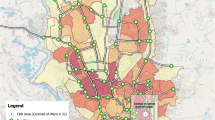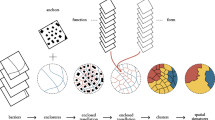Abstract
Buildings are an essential component of urban form. Urban morphologists know that buildings can be classified by type, but types are specific to given cultural areas. In a transnational context, detailed expert knowledge is not always available, hence the need for identifying typologies of buildings inductively from large urban databases exists. This paper presents the application of a Bayesian Network clustering protocol to buildings and the study of the spatial aggregates of the obtained family types for two metropolitan areas located in countries with marked cultural and societal differences: Osaka-Kobe in Japan and Marseille-Provence in France. Six indicators of building characteristics are calculated and used to perform the clustering: Footprint Surface, Elongation, Convexity, Number of Adjoining Neighbors, Height and Specialization. Cluster results are first extracted, detailed and analyzed and then, building type prevalence is studied at the metropolitan scale using local indicators of network-constrained clusters (ILINCS). The building families obtained through clustering show that these two coastal metropolitan areas are made up of apparently similar “ingredients” (very similar typologies are found at the relatively coarse level of detail of our study), but with different weights and spatial organization. This approach is appropriate for the automated processing of large building datasets and the results are a good entry point to study the link between building families, urban development periods and urban functions.





Similar content being viewed by others
Notes
A topological neighborhood of order 3 was used to delimit the surrounding values.
References
Anselin L (1995) Local indicators of spatial association. Geogr Anal 27(2):93–115
Araldi A, Fusco G (2017) Decomposing and recomposing urban fabric: the city from the pedestrian point of view. In: Gervasi O et al. (eds) Computational science and its applications—ICCSA 2017, proceedings, part IV. Lecture notes in computer science, vol 10407, pp 365–376
Araldi A, Perez J, Fusco G, Fuse T (2018) Multiple fabric assessment: focus on method versatility and flexibility. In: Gervasi O et al (eds) Computational science and its applications—ICCSA 2018. ICCSA 2018. Lecture notes in computer science, vol 10962. Springer, Cham
Berghauser Pont MY, Haupt P (2010) SPACEMATRIX, space, density and urban form. NAi Publishers, Rotterdam, p 279
Biljecki F, Ledoux H, Stoter J (2016) An improved LOD specification for 3D building models. Comput Environ Urban Syst 59:25–37
Brown FE, Steadman JP (1991a) The morphology of British housing: an empirical basis for policy and research. Part 1: functional and dimensional characteristics. Environ Plan B Plan Des 18:277–299
Brown FE, Steadman JP (1991b) The morphology of British housing: an empirical basis for policy and research. Part 2: topological characteristics. Environ Plan B Plan Des 18:385–415
Caniggia G, Maffei GL (2001) Architectural composition and building typology: interpreting basic building Alinea Editrice, Firenze; translated by S.J. Frazer, first published in Italian in 1979
Conzen MRG (1969) Alnwick, Northumberland: a study in town-plan analysis, vol 27, 2nd edn. Institute of British Geographers Publication, London
Dempster AP, Laird NM, Rubin DB (1977) Maximum likelihood from incomplete data via the EM algorithm. J R Stat Soc B 39(1):1–38
Duda RO, Hart PE (1973) Pattern classification and scene analysis. Wiley, New York
Fisher F (2001) Building bridges through participatory planning, part I, UN-HABITAT. https://unhabitat.org/books/building-bridges-through-participatory-planning-part-1/. Accessed 25 Aug 2018
Fusco G (2016) Beyond the built-up form/mobility relationship: spatial affordance and lifestyles. Comput Environ Urban Syst 60:50–66
Fusco G, Araldi A (2017) Significant patterns in urban form. Spatial analysis of morphological indicators. Revue Internationale de Géomatique, 4/2017, pp 455–479
Fusco G, Perez J (2019) Bayesian network clustering and self-organizing maps under the test of Indian Districts. A comparison. Cybergeo Eur Geogr Syst Modél Géostat (Document 887)
Galan Aguilar MP (2015) Participatory design for public urban spaces. UN Global Compact Cities Programme, Melbourne
Giedion S (1948) Mechanization takes command, a contribution to anonymous history. Oxford University Press, Oxford
Gil J, Beirao JN, Montenegro N, Duarte J (2012) On the discovery of urban typologies: data mining the many dimensions of urban form. Urban Morphol 16(1):27
Gourdon J-L (2001) La rue, essai sur l’économie de la forme urbaine. La Tour d’Aigue: Editions de l’Aube
Haggag MA, Ayad HM (2002) The urban structural units method: a basis for evaluating environmental prospects for sustainable development. Urban Des Int 7:97–108
Hanna S (2007) Automated representation of style by feature space archetypes: distinguishing spatial styles from generative rule. Int J Archit Comput 5:2–23
Hecht R (2014) Automatische Klassifizierung von Gebäudegrundrissen. Ein Betrag sur kleinräumigen Beschreibung der Siedlungstruktur. IÖR Schriften Band 63. Rhombos-Verlag, Berlin
Hillier B (1996) Space is the machine. Cambridge University Press, Cambridge
Langley P, Iba W, Thompson K. (1992) An analysis of Bayesian classifiers. In: Proceedings of the tenth national conference on artificial intelligence, San Jose, pp 223–238
Le Corbusier (1924) Mass produced housing, translated by Tim Benton. Architecture and design, 1890–1939: an international anthology of original articles. The Whitney Library of Design. New York, 1975
Maceachren A (1985) Compactness of geographic shape: comparison and evaluation of measures, Geografiska Annaler. Ser B Hum Geogr Wiley 67(1):53–67
Martin L, March L (1972) Urban space and structures. Cambridge University Press, Cambridge, p 282
Meinel G, Hecht R, Herold H., Schiller G (2008) Automatische Ableitung von stadtstrukturellen Grundlagendaten und Integration in einem Geographischen Informationssystem. Technical Report 134, Bundesamt für Bauwesen und Raumordnung, Bonn
Mies van der Rohe L (1924) The industrialization of building methods. G: Zeitschrift für elementare Gestaltung, 3, June 1924
Moriconi-Ebrard F, Perez J (2016) Macro-structure urbaines et potentiel de développement en Chine. Institut e-Geopolis, rapport Chinapolis, p 76
OECD (2013) Vers une croissance plus inclusive de la métropole Aix-Marseille: Une perspective internationale. OECD report, p 221
Okabe A, Sugihara K (2012) Spatial analysis along networks: statistical and computational methods. Wiley, Hoboken
Popham P (1985) Tokyo: the city at the end of the world. Tokyo: Kodansha International
Reffat R (2008) Investigating patterns of contemporary architecture using data mining techniques. In: 26th eCAADe proceedings, pp 601–608
Reibel M (2014) Classification approaches in neighborhood research: introduction and review. Urban Geogr 32:305–316
Reibel M, Regelson M (2007) Quantifying neighborhood racial and ethnic transition clusters in multiethnic cities. Urban Geogr 28:361–376
Rissanen J (2007) Information and complexity in statistical modeling. Springer, Heidelberg
Roncayolo M (1996) Les grammaires d’une ville. Essai sur la genèse des structures urbaines à Marseille. Editions de l’Ecole des Hautes Etudes en Sciences Sociales, Paris
Royall RA, Wortmann T (2015) Finding the state space of urban regeneration: modeling gentrification as a probabilistic process using k-means clustering and Markov models, CUPUM 2015 Proceedings, Paper 275
Russell SJ, Norvig P (2003) Artificial intelligence: a modern approach, 2nd edn. Prentice Hall, Upper Saddle River, p 1080
Ruz GA, Pham DT (2009) Building Bayesian network classifiers through a Bayesian complexity monitoring system. Proc IMechE 223(C3):743–755
Sassen S (2005) The global city: introducing a concept. Brown J World Aff 11(2):27–43
Scheer BC (2015) The epistemology of urban morphology. Urban Morphol 19(2):117–134
Schirmer P, Axhausen K (2015) A multiscale classification of urban morphology. J Transp Land Use 9(1):101–130
Serra M, Lopes Gil JA, Pinho P (2013) Unsupervised classification of evolving metropolitan street patterns. In: Proceedings of ninth international space syntax symposium, p 46
Shelton B (2012) Learning from the Japanese city: west meets east in urban design. Routledge, Taylor & Francis, p 224
Shoultz G, Givens J, Drane W (2007) Urban form, heart disease, and geography: a case study in composite index formation and bayesian spatial modeling. Popul Res Policy Rev 26(5–6):661–685
Sokmenoglu A, Cagdas G, Sariyildiz S (2011) Application of data mining in micro-scale urban feature analysis. Proc GeoComput 2011:154–160
Son JS, Thill JC (2018) Is your city economic, cultural, or political? Recognition of city image based on multidimensional scaling of quantified web pages. In: Thill JC (ed) Spatial analysis and location modeling in urban and regional systems. Springer, New York, pp 63–95
Sorensen A (2002) The making of urban Japan: cities and planning from Edo to the twenty-first century. Routledge, Abingdon, p 386
Steadman P (2014) Building types and built forms. Troubador Publishing Ltd, Leicester, p 420
Steadman P (2016) Research in architecture and urban studies at Cambridge in the 1960s and 1970s: what really happened. J Archit 21(2):291–306
Steadman P, Bruhns HR, Holtier S, Gakovic B (2000) A classification of built forms. Environ Plan B Plan Des 27:73–91
Vialard A (2013) A typology of block-faces. PhD Dissertation, Georgia Institute of Technology, USA. https://smartech.gatech.edu/handle/1853/52182
Yamada I, Thill JC (2010) Local indicators of network-constrained clusters in spatial patterns represented by a link attribute. Ann Assoc Am Geogr 100(2):269–285
Acknowledgements
This research was carried out thanks to a Grant-in-Aid for Scientific Research from the Japan Society for the Promotion of Science (JSPS). This study is supported by Joint Research Program no. 774 at CSIS, UTokyo (Zmap TOWN II 2013/14 Shapefile Osaka prefecture).
Author information
Authors and Affiliations
Corresponding author
Additional information
Publisher's Note
Springer Nature remains neutral with regard to jurisdictional claims in published maps and institutional affiliations.
About this article
Cite this article
Perez, J., Fusco, G., Araldi, A. et al. Identifying building typologies and their spatial patterns in the metropolitan areas of Marseille and Osaka. Asia-Pac J Reg Sci 4, 193–217 (2020). https://doi.org/10.1007/s41685-019-00127-6
Received:
Accepted:
Published:
Issue Date:
DOI: https://doi.org/10.1007/s41685-019-00127-6




